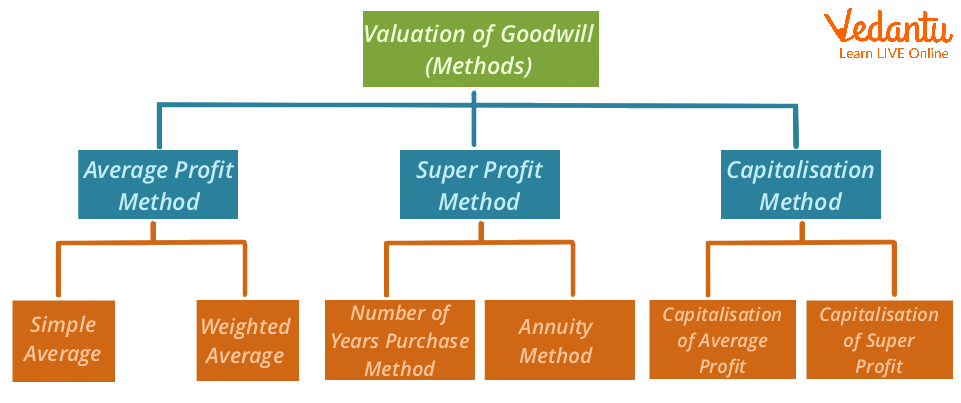




Concept of Goodwill
Goodwill may be estimated in many ways. Goodwill may be valued in many ways, one of which is via a Capitalisation Profit Method analysis. Using the capitalised value of the firm's earnings, one may calculate the needed investment to achieve the target return, as proposed by the Capitalisation Method.
Capitalisation is the sum of money needed to make a certain quantity of money at a standard rate of return. Using a standard rate of return, this approach determines the capitalisation value of the typical profit. Once the average profit has been capitalised, the company's Net assets may be used to determine the goodwill. This helps estimate the starting capital required to generate a typical profit.

Valuation of Goodwill Meaning
Types of Capitalisation Method

Defining the Method of Valuation of Goodwill
Capitalisation Method
This method for the valuation of goodwill is divided into two parts. These are as follows:
Capitalisation of Average Profits: Using this method, the capitalised value of average profits is calculated using the standard rate of return, and the actual capital employed is subtracted to determine the value of goodwill. The capitalisation method formula is:
Value of Goodwill = Standard Capital - Capital Used.
Profits on average multiplied by 100 divided by the standard rate of return yields average capital.
Number of Capital Investments = Total Assets - Noncurrent Liabilities (excluding goodwill)
Capitalisation of Super Profits: This approach uses the capitalisation of super profits to capitalise on goodwill directly. The calculation of goodwill by capitalisation method comes into play when the value of a company's good name is 100 times the abnormal profit margin divided by the average return rate.
Important Aspects of Goodwill Valuation

The Most Important Aspects of Goodwill Valuation
If the departing chairman is the primary driver of the company's success, goodwill value may be one or two years' worth of profits. Traditional payback periods range from three to five years after purchase.
If the super profit is high or the firm is very lucrative, an extended amount of time may be required.
Whether the firm is making superprofits or just average earnings, goodwill might rise if there are several interested buyers.
A company's bottom line may be red ink at times. But, even then, goodwill payments might be made if the company's future seems bright.
For an acquiring firm, it's not only about the money it makes after a merger but also about the efficiencies it gains.
The company's technology, research and development, client base, and industry of operation may all play a role in the goodwill assessment process.
Methods for Valuation of Goodwill
A company adopts the valuation method consistent with the market practices of the trade and the position maintained by it. The different methods of valuation of goodwill are mentioned below.
1. Average Profits Method
The average profits method primarily takes the following two forms -
Simple Average
Here, the goodwill is evaluated by the calculation of average profit against the number of years purchased.
Weighted Average
This method is usually used in the instances of alterations of profit while also focusing on the current year’s profit. It calculates the previous year’s profit for obtaining the valuation.
2. Super Profits Method
The super profit method of valuation of goodwill covers the excess of the maintainable profits in the future as opposed to the normal profits. The formula is indicated below.
(Super profit = Average / Actual profit – Normal profit
Normal profit = (Capital employed X Normal rate of return) / 100)
The super-profits method can be undertaken by either of the two following methods.
Annuity Method of Goodwill
The annuity method in the valuation of goodwill uses the average super profit over a specific number of years. The current value of an annuity is found on the basis of a discounted amount of super profit at the established rate of interest.
Purchase Method by Number-of-Years
Super profits in a definite number of purchase years are evaluated for establishing goodwill.
3. Capitalisation Method
In the goodwill capitalization method, there are two ways in which the calculation can be done.
Average Profits Method
The calculation covers the deduction of its actual capital that has been employed from the average profits of the capitalized value. It is undertaken based on the normal rate of return.
(Capitalised average profits = Average profits X 100 / Normal rate of return
Actual capital employed = Total assets (excluding goodwill) – Outside liabilities)
Super Profits Method of Valuation of Goodwill
In these methods, super profits are directly capitalized for the valuation of goodwill.
Illustration
Ram and Mohan are business partners, and each has a credit amount of 1,250,000 in the company's Capital account and 15,000 and 10,000 in the current A/c, respectively. A business's typical rate of return is 10%, and the average profit is 50,000. Use the Capitalisation of Average Profit Approach to determine goodwill.
Solution: Capitalised Value of the Average Profit Calculation:
To calculate the average profit value
= Average profit x 100/ Normal rate of return
= 50,000 x 100/10
= 5,00,000
Calculation of Firm’s Goodwill
Value of Goodwill = Average Profit Divided by Total Capital Invested (Net Assets)
Capital Employed = 1,25,000+ 1,25,000+ 15,000+10,000
Goodwill employed = 2,75,000
Goodwill = 5,00,000 − 2,75,000
Goodwill = ₹ 2,25,000
Conclusion
A cash expenditure may be capitalised according to accounting rules so that it shows up as an asset on the balance sheet instead of a liability on the income statement. The cost of fixed assets, such as computers, automobiles, and office buildings, is recorded on the general ledger as the historical cost of the asset, and it is not expensed in full against profits in the current accounting period.
FAQs on Valuation of Goodwill: Methods and Examples
1. What is meant by the valuation of goodwill?
The valuer's assumption is used to determine the value of goodwill. Unlike new businesses, a successful company establishes a reputation in the market, builds trust with its customers, and has a larger network of business contacts. All of these factors are taken into account when appraising a firm, and the financial value that a consumer is willing to offer is referred to as goodwill.
Customers who purchase a firm based on its goodwill expect to make huge gains. As a result, goodwill only applies to companies that generate super-profits, not to those that make normal losses or profits. It is an intangible real asset that cannot be seen or felt but may be purchased and sold in reality. To acquire more knowledge, click here.
2. What are the methods of valuation of goodwill?
The value of goodwill is done in a variety of methods. The valuation methodologies, on the other hand, are based on the condition of a certain firm as well as diverse trade practices. The top three methods for valuing goodwill are listed below.
Average Profits Strategy- There are two subdivisions to this method.
Simple Average- In this method, the value of goodwill is calculated by dividing the average profit by the number of years purchased. The formula may be used to compute it. Goodwill is calculated by multiplying the average profit by the number of years after the acquisition.
Weighted Average- In this case, the profit from the previous year is determined using a set of weights. It is used to calculate the average weight profit by dividing the value of items by the total number of weights.
When there is a change in profits, this strategy is utilized to emphasize the current year's profit. The formula is used to assess it. Goodwill is Weighted Average Profit multiplied by the number of years from the purchase, where Weighted Average Profit = Profits multiplied by weights/Weighted Average Profit.
Surplus Method- It's the difference between typical earnings and predicted future sustaining profits. These are the two approaches of these methods.
The Method of Purchase is based on the Number of Years. The goodwill is calculated by multiplying super-profits by a specific year of purchase. It may be calculated using the formula below. Actual or Average Profit – Normal Profit = Super Profit
The average super profit is taken as an annuity value over a set number of years in this method. The current value of an annuity at a certain rate of interest is calculated using a discounted amount of super profit. This is the formula to utilize:
Super Profit x Discounting Factor Equals Goodwill
Capitalization Method: Two ways can be used to assess goodwill in this manner.
Goodwill is calculated using the average profits method, which subtracts the original capital deployed from the capitalized amount of average profits based on the average return rate. The formula that was utilized is listed below.
Average Profits x (100/average return rate) = Capitalised Average Profits
Super Profits Method: It is used to capitalize the super profit and determine the goodwill. The formula that was used is. Super Profits x (100/ Normal Rate of Return) = Goodwill.
3. What are the special considerations that should be taken into account during the calculation of goodwill?
The special considerations that should be taken into account during the calculation of goodwill are the following:
Although goodwill is the premium paid above an entity's fair value during a transaction, the value of goodwill cannot be sold or purchased as an intangible asset in and of itself.
As goodwill is made up of subjective qualities, determining its worth can be difficult. In transactions involving goodwill, there is a significant danger that the acquiring business would overvalue the acquired goodwill and end up paying too much for the acquired corporation.
Despite its intangibility, goodwill is measurable and a critical component of a company's worth.
4. What are the factors that affect the valuation of goodwill?
The factors that affect the valuation of goodwill are the following:
Management: A company with good management has a lot of productivity and saves a lot of money. This results in greater earnings as well as a high level of goodwill.
The Reputation of the Owner: An owner with a positive personal reputation in the market, who is honest and trustworthy, draws more clients to the firm, resulting in increased earnings and goodwill.
The Situation of the Market: Having a monopolistic right or situation in the market, or having limited competition, allows an organization to produce large profits, which leads to a greater goodwill value.
Type of Business: A company that deals with high-quality items or has a steady demand for its product may make more money and so has greater value.
Special Benefits: A company with particular benefits such as import licenses, patents, trademarks, copyrights, guaranteed low-cost power, subsidies for being located in special economic zones (SEZs), and so on has a greater goodwill value.
5. What is the meaning of hidden goodwill?
Hidden goodwill occurs when the value of goodwill is not provided at the time of a new partner's admission and must be calculated from the capital and profit sharing ratio arrangement.
A and B, for example, are partners who split earnings equally and each has a capital of Rs.50,000. They accepted C as a new partner in exchange for a one-third profit split. C invests Rs.60,000 in his business. The entire capital of the newly formed business is Rs.1,80,000 (Rs. 60,000 3), based on the amount brought in by C and his share of profit.
However, A, B, and C's total capital is Rs.1,60,000 (50,000 + 50,000+ 60,000). As a result, the difference, Rs.20,000 (1,80,000 – 1,60,000), may be attributed to goodwill. For access to the free study materials, access the Vedantu app and website.
6. What is the Importance of Goodwill?
An intangible asset, goodwill, is connected with the purchase of one firm by the other. It relates to such part of the purchase price that is greater than the aggregate of the net fair value of the purchased assets.
It helps in enhancing the value of the business as well as acquiring a greater customer base. It also includes a reputation that indicates an established track record of the company.
7. How to Calculate Goodwill?
The calculation of goodwill takes into account the parameters of the fair value of liabilities and the fair value of assets of the business that has been acquired. The derived sum is then further added to the fair value of the liabilities and assets of the purchasing business. The formula is-
Goodwill = Number of years X Average profits |
Solution
Normal Profit = Capital employed X Normal rate of return / 100
= 4,00,000 X 10 / 100 (Putting the values)
= 40,000
Super Profit = Average profit – Normal profit
= 60,000 – 40,000 (Putting the values)
= 20,000
Goodwill = Super profits X 100 / Normal rate of return |
=20,000 X 100 / 10
= 2,00,000 (Answer)
8. What is meant by the capitalisation of superprofits?
In the capitalisation approach, there are two ways to determine a profit:
The Average Profit Capitalisation Method
The capitalisation of super profits method
Using the normal rate of return, the capitalisation of average profits is subtracted from the actual capital employed to arrive at the goodwill value in the capitalisation of average profits approach.
Capitalisation method of goodwill formula:
Capitalised Average Profits minus Expended Capital Gives You Goodwill. where,
Normal Capitalisation Rate = Average Estimated Profits x 100 / Normal Rate of Return
Net Asset of Business = Total Assets - Liabilities owed to third parties (excluding goodwill, non-traded investments, and intangible assets).
9. What are the steps in calculating goodwill by a capitalisation of the average profit method?
The following are the steps in calculating goodwill by a capitalisation of average profit method:
Step 1: Estimate the average profit.
Step 2: Determine capitalised average profits.
Step 3: Determine the worth of the actual capital used by the firm or the company's net assets.
Step 4: Determine the value of the goodwill by deducting the actual capital utilised from the capitalised average profit.
Method of Capitalisation of Super Profits In this approach, the value of the company's goodwill is figured out by capitalising the company's super profits based on the usual rate of return.
10. What is an example of the capitalisation method?
The following example will serve to clarify the idea of capitalisation of the average profit approach. With an initial investment of $5,000,000, Bhatt and Sons can make a profit of $9,000,000. The average rate of profit is 15% a year. The capitalisation method for goodwill is used when the super profit approach comes into play to calculate goodwill worth.
Solution: Rational Gain = Capital Utilised x Typical Rate of Return / 100
= 5,00,000 x 15 / 100
= 75000
An Extraordinary Profit is a Difference Between an Ordinary Profit and a Super Profit.
= 90000 - 75000
= 15000
In other words, goodwill is calculated as follows: goodwill = normal rate of return * average annual super profit = 15000 x 100 / 15




































